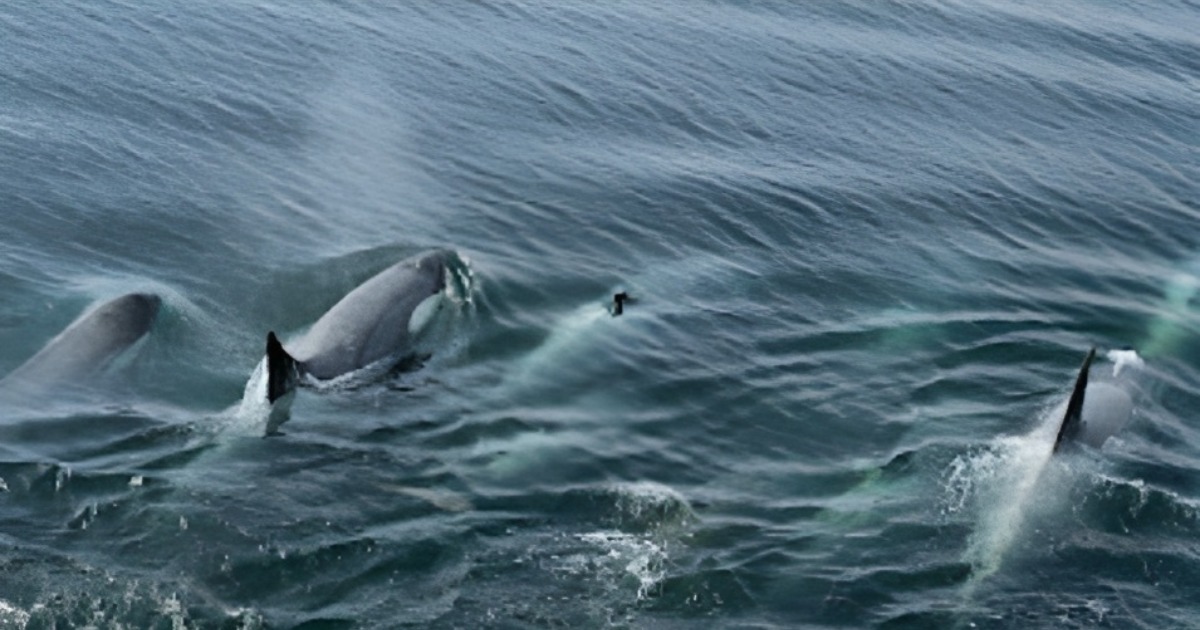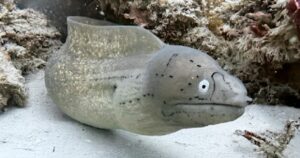When Nature decided that our planet needed a versatile, most formidable predator, it created the Orca. We can talk about the power and strength of these animals for quite a long time, but today we’ll tell you something that usually no one even remembers. Get ready to see orcas in a way you’ve never seen them before.
A peculiar creature was washed up on the shores of Kate SED La Vidy near Vlasto, leaving the locals puzzled. Its unique coloration and unusual shape had everyone wondering. Eventually, they suspected it might be a young orca that had passed away under mysterious circumstances. Anyone who has seen a grown orca would agree this creature looked nothing like one. Most likely, decomposition played a significant role here, as it’s hard to determine how long the calf had been lying on the shore, causing it to change almost beyond recognition.
Decomposition
Decomposition affects all organisms sooner or later and follows a similar pattern for most beings. Just like with humans, when deceased animals aren’t properly cared for, their bellies start to swell up rather quickly. Gases tend to build up inside their bodies, and sometimes it can lead to internal pressure. This is a common occurrence among all animals, especially in those with thick skin. When the skin cracks, you might see bodily fluids oozing out, and trust me, it’s as unpleasant as it sounds. But what about orcas?
Orca passes away
So, when an orca passes away, even a young one, its body begins to undergo changes as its insides break down. It starts filling up with gases like methane and hydrogen sulfide. These gases need a way out because the orca’s body can only stretch so much.
The outcome depends on where the orca meets its end. If it happens at sea, scavengers like sharks can release the internal pressure, not because they’re trying to harm the orca but because they’ll just consume it.
However, if an orca is washed ashore, its substantial weight can block the openings. When the sun’s heat intensifies, those gases build up even faster, causing the orca to expand until, well, let’s just say until it could rupture. You wouldn’t want to be nearby when this happens.
Stranded orca
When you come across a stranded orca, it’s like finding any other deceased whale, a somber event that unfortunately happens quite often. Now, let’s talk about Ben. When you spot Ben from a distance, you might not realize right away that he’s an orca.
His dorsal fin is quite unusual, split into two parts with a larger back part jutting off to the side. But if you know that this unique fin belongs to Ben, he instantly becomes the most distinctive orca in the world.
Ben stands out not just for his unique appearance but also for his remarkable survival story. He’s an orca who has cheated death twice thanks to the scars from his daring adventures. Ben has unwittingly become an icon for adventurers.
It’s not that scientists study his scars; it’s just that Ben gets photographed quite a bit, and his battle scars serve as a clear identifier in the snapshots. This helps researchers track the whereabouts of whales in the waters around New Zealand and measure the impressive distances they can cover.
It all started in 1997, at least according to Dr. Ingrid Visser, founder of the Orca Research Trust. That’s when Ben stranded on a beach near the town of Monga, just north of Auckland. The plan was to end the orca’s torment, but Dr. Visser was able to intervene, and Ben was successfully returned to the water after 21 hours. Unfortunately, the poor orca seemed to have a stroke of bad luck the next year.
He was spotted with a major injury to his dorsal fin, which had been caused by a collision with a boat. According to Visser, this injury could have been fatal. It was such a serious wound that experts seriously questioned whether Ben would make it through. This was because the dorsal fin is a crucial body part for someone like Ben, who lives and hunts in the water.
But Ben amazed everyone with his resilience. Since his injury, researchers, dolphin enthusiasts, and ordinary people have spotted him over 140 times in different parts of New Zealand. Despite his injury, he’s covered at least 24,800 miles, which is basically like swimming around the world. Ben could definitely give motivational speeches to orcas.
Orca’s dorsal fins
Let’s talk about orca’s dorsal fins for a moment. It’s important to note that these fins are somewhat vulnerable, not in the sense that they’re easily damaged but in a more serious way. All orcas sport a fin on their backs, but males have a significantly taller one compared to females, reaching up to about 6 ft in height. People have been arguing for a while about why some orcas have dorsal fins that bend or flatten.
Advocates for animal rights say these fins get hurt because the orcas aren’t living well in captivity. But people who own theme parks in places with dolphin shows where orcas do tricks say the opposite, claiming this bent fin thing is just how it is naturally. It’s called flaccid fin or folded fin syndrome.
Although the dorsal fin is very straight, it’s supported not by bone but by a fibrous connective tissue called collagen. This is what it looks like in cross-section. Folded fin syndrome in wild orcas can result from age, stress, injuries, or interactions with other orcas; however, it’s most frequently observed in captive orcas.
Again, this condition can be caused by stress, dietary changes, temperature fluctuations, or more complex factors. Here’s what happens: water pressure helps keep the orca’s fin in good shape and upright. Yet in captivity, even in the best conditions, this support diminishes because captive orcas tend to stay near the water’s surface rather than diving deep. As a result, the fin tissue loses support and eventually droops.
Structure of an orca’s fin
When you get to know the structure of an orca’s fin, it helps you understand why their fins can sometimes get all bent out of shape. In fact, they can get so twisted that you might not even recognize the creature from a distance.
Take this adult male orca, for instance, spotted in the waters of New Zealand; his fin looks like a zigzag, and experts think it happened when he got caught up in a fishing line and gave it a good tug. Just take a look at what happened to it due to its unusual appearance; people even gave this orca the nickname “Cork.”
What about an orca that has no dorsal fin?
A group of researchers encountered a 3-month-old orca off the southern coast of Western Australia, and to their surprise, the little orca had no dorsal fin. Despite this peculiar condition, the young whale seemed perfectly healthy and at ease as it swam alongside its family members. While experts couldn’t definitively figure out the reason behind the missing fin, they did have a few theories.
The first theory
Given the calf’s age, it seemed unlikely that the fin was lost due to a boat or human interference. The first theory is a congenital genetic defect; it’s simple and straightforward. The second theory says that orcas might get injured during childbirth.
In the wild, there have been cases where other orcas in the family assist a pregnant female in giving birth; sometimes they even help pull out the calf if the mother is struggling. Since baby orcas are born with their dorsal fin facing forward, this is the part that the orcas pull on to. They try to be careful, but accidents can happen, especially during challenging births. So, it’s possible that the adult orcas accidentally injured the fin, and it eventually fell off. It’s worth mentioning that the baby orca is lucky to have this condition from an early age.
Adaptability
This gives it plenty of time to adapt and lead a fairly normal life down the road. The only limitation is that such an orca might need to move a bit differently. However, if an adult loses its dorsal fin, it could mean a difference between life and death.
As I mentioned earlier, the dorsal fin is crucial for orcas, just like many other animals. It helps them maintain balance and maneuver better. An adult orca would have to learn how to swim again, and during that learning process, it would be vulnerable and probably hungry too.
In a situation like this, the animal can only rely on luck or its family. A few years back, near Gabera in South Africa, people spotted an orca in dire straits. This young animal had no dorsal fin and was missing its right pectoral fin. According to the tough rules of the wild, the poor creature should have been a goner. However, it turned out that this crippled orca managed to pull through with some help from its fellow orcas.
Thanks to its injury, the orca couldn’t go hunting solo; even swimming would prove challenging. But instead of leaving their young fellow orca to fend for itself, the family pitched in and shared their catch. What may seem to be completely normal behavior for humans is actually a unique case for animals.
It proves once again that these mammals are not just the ruthless killing machines they sometimes appear to be. Orcas have complex social structures, and they care for their crippled relatives, even if it doesn’t benefit them.
Orcas troubles
Regrettably, it’s not just their fins that give orcas trouble. Take Stumpy, for instance, who lives in the waters off Norway. Stumpy’s got quite a unique but heart-wrenching tale to tell. You see, he’s dealing with a pretty significant issue with his back. When he’s underwater, it’s noticeable that he has to put in more effort to move his tail compared to other orcas. Stumpy was born around 1995 or 1996.
During the first encounter with researchers, his mom was seen swimming near him with a pod of other orcas, but neither Stumpy nor his mom was a part of it. They were kind of on their own, and that was already quite unusual.
However, things only got weirder from there. Stumpy had been seen for some time, and at the time, it was widely assumed that he hadn’t survived the trauma. Not because scientists didn’t believe in the baby orca; it’s just that it’s almost impossible to deal with such serious injuries. However, it later turned out that Stumpy was very much alive.
What’s intriguing is that he traveled long distances, but he consistently followed pods of other orcas. What’s even more fascinating is that, due to the extent of his injuries, he struggled to hunt for food by himself. Essentially, during this time, he relied on completely unfamiliar orcas for assistance, and they actually helped him. Something like this is a very rare occurrence. Overall, Stumpy was really lucky.
In 2004, scientists noticed something fascinating about Stumpy. He was spotted having a meal near a group of orcas, while two other orcas brought him some herring. He would stay far away from the feeding area and wait for the food to be carried right to him. Besides helping him grab a bite, some of the other orcas also acted as his bodyguards. One interesting thing the researchers saw was that it was pretty tricky to approach Stumpy in a boat; the other orcas swiftly guided him away from any potential danger.
What else has nature got in store for us?
Fully white orcas! Whale watchers in Japan recently saw two white orcas swimming side by side. This unusual orca coloration may be the result of albinism or leucism. Albinism occurs due to issues with melanin production, impacting the overall appearance of an orca’s skin, fur, and eyes. Leucism, a related condition, arises from pigment cell abnormalities, leading to a spotted appearance in carriers. In orcas, albinism is often linked to close inbreeding.
Although it doesn’t seem to harm their health, they simply turn white, and that’s it. Leucism is the result of a random genetic mutation, meaning that it can happen to absolutely any orca. But this condition also doesn’t affect the health of orcas. Due to both orcas being white, they have some pretty noticeable scratches on their bodies from other orcas’ teeth. These marks likely came about during play rather than an actual brawl. The black orcas also have some marks, but they’re not as easy to spot.
What’s intriguing is that these white orcas are of different ages. They were caught on film together in 2021, with one of them being seen 2 years earlier, but the others showed up for the first time. It’s hard to pinpoint the exact number of white orcas worldwide. What we do know is a rough estimate that suggests only about one in a thousand orcas in the western North Pacific is white, which happens to be the highest concentration anywhere on Earth. In other regions of the world, these unique white orcas are even more scarce.
And now for the most unusual orca I’ve ever heard of, and I’ve read quite a bit about them. When you see the heads of these animals sticking out of the water, you’re probably thinking, “Are those orcas without spots like a white one, only the other way around?” But you would be very far from the truth because you’d be looking at false killer whales.
False killer whales
False killer whales and regular orcas belong to the same family, but they have noticeable distinctions.
To start, let’s talk about their appearance. False killer whales are typically all black or dark gray without any white spots. In comparison, regular orcas, which are larger, can have white markings. Speaking of size, false killer whales are smaller, with males growing up to about 20 ft in length and weighing around 3,300 lbs, while females reach lengths of up to 16 ft and weigh up to 2,200 lbs. On the other hand, regular orcas can reach lengths of up to 30 ft and weigh more than 11,000 lbs. The contrast in size is quite remarkable.
False killer whales are known for their friendly and sociable nature, but this trait can sometimes lead to unfortunate situations, such as getting stranded on the shore as a group, following a single family member. In addition, false killer whales are considered mesopredators, that is, mid-level predators that feed on smaller prey and are hunted by larger predators. As for the regular orcas, well, as you know, they reign supreme in the realm of predation.
But even orcas aren’t immune to the influence of trends and memes. Back in 1987, they unexpectedly embraced a quirky fad: wearing hats made from dead salmon. This unusual phenomenon was observed in the Puget Sound area of the northeastern Pacific Ocean when a female orca started sporting a dead salmon as a hat on her nose. It may sound like a coincidence, but within the next 5 to 6 weeks, this behavior spread like wildfire.
Eventually, orcas from her group and two others hopped on the bandwagon, all sporting the same fishy headgear. Then, just as abruptly as it began, this trend vanished, except for a few instances the following summer.
Mysterious disease
Scientists have been noticing odd marks on orca’s skin for quite a few years now. These marks aren’t your typical scars, bite marks, or burns; they’re more like changes in the skin itself. Over time, they gathered some data, and it turns out the most common types of these marks are either gray patches or target-like spots. While they might look pretty, it’s actually a sign of some kind of illness. Unfortunately, that’s where the information stops. Scientists think a microbe might be behind these marks, but they’re not sure what exactly.
It’s up to one. Thing they do know is that this microbe doesn’t seem to be the cause of death for orcas. As for any other effects it might have on these creatures, well, that’s still a mystery.
While we’re talking, I found something unusual: a new species of orca, a brand new species. Fishermen and tourists have been sharing tales and snapping numerous photos of an enigmatic orca that stands out from the rest. Just recently, researchers stumbled upon a couple dozen distinct orcas swimming along the shores of southern Chile. Right now, scientists are eagerly awaiting the results of DNA tests on a tissue sample, but they suspect they might have stumbled upon a whole new species.
Orcas have a distinct feature with a large white eye patch, although it’s barely noticeable in this particular species. Their heads have a slightly more rounded shape and are less smooth compared to common orcas. Additionally, their dorsal fins are narrower and pointed. These differences might seem minor to us, but scientists believe that these species are so distinct from each other that it’s unlikely they can interbreed. I’m planning to follow the updates from these scientists, and if I come across something intriguing, I’ll let you know.



